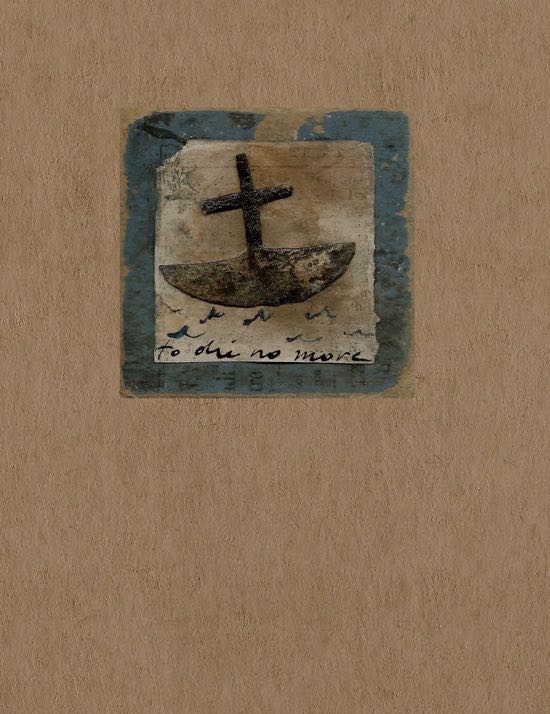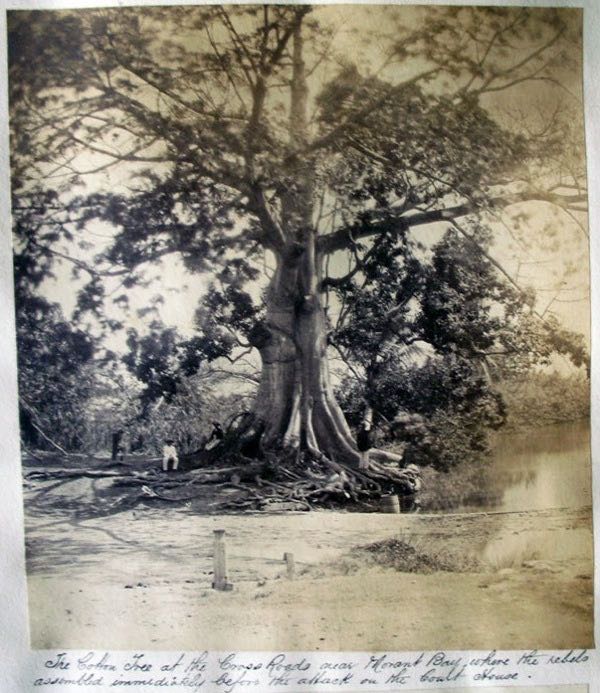
April - July 2012

18 July 2012
“ What is a book but the record of the struggle of a story to tell itself ? ”
— Henry
Wessells on the work of Peter Straub, at Readercon.
One of the great delights of this year’s Readercon was the Panel on the Works of Peter Straub, a wide-ranging, zigzag conversation — we connected minor characters across the decades — between Gary K. Wolfe, Mike Allen, John Langan, and your correspondent ; and to see how pleased the author was by the seriousness (and sly humor) with which we discussed character, place, and story in Straub, as well as a host of other topics.
The talk on Critical Fiction and other Fabulous Beasts was well attended and well-received. Your correspondent read the introduction to My Man and other Critical Fictions by Wendy Walker and proposed definitions by examples. The second half of the program included the first public performance of “ Book becoming power ” a critical fiction on the writings of Don Webb ; and The Private Life of Books, a series of poems. Members of the audience proposed other works as possible examples of critical fictions and raised the issue of the links between pastiche and critical fiction. Thank you to all who attended both events ; recordings were made and excerpts or transcripts will be made available. The long conversation continues . . . .
All American Literature : Multiple Choice
All American literature since
a) 1798
b) 1890
c) 1923
must now be viewed — whether we wish to or not — in terms of PTSD : confrontation of (rare) ; or denial (mostly).
a) Charles Brockden Brown. Wieland ; or, The Transformation (1798)
b) Ambrose Bierce. “ An Occurrence at Owl Creek Bridge ” (1890)
c) Ernest Hemingway. Three Stories and Ten Poems (1923)
Discuss.
30 June 2012
Between no and yes
“ Between no and yes. Between is and is not. That’s where the interesting stuff is. ” — Peter Straub, In the Night Room
On Friday 13 July, your correspondent will be at Readercon, in Burlington, Mass., and, in that ambiguous space between no and yes, moderating a panel to discuss the works of Peter Straub. The other panelists will include : Mike Allen, Ken Houghton, Caitlin R. Kiernan, John Langan, and Gary K. Wolfe. Questions concerning the work of the novelist may be sent to : wessells [at aol [dot] com .
On the Saturday, 14 July, I will be giving a short talk entitled : Critical Fictions & Other Fabulous Beasts; or, Learning to Read and Write All Over Again. You think you know how to read ? This look at critical fictions and other modes of reading/writing will suggest that it might be time to learn it all over again.
Schedule:
13 July
8:00 p.m. The Works of Peter Straub. Mike Allen, Ken Houghton, Caitlín
R. Kiernan, John Langan, Henry Wessells (leader), Gary K. Wolfe.
14 July
8:00 p.m. Critical Fictions & Other Fabulous Beasts; or, Learning to Read and Write All Over Again.
I will have copies of all available Temporary Culture titles, including My Man and other Critical Fictions by Wendy Walker. Come say hello.
Recent reading :
— Peter Straub. In the Night Room. Random House, [2004].
— Edmund Crispin. The Long Divorce (1951) ; Penguin paperback, [1984].
— — . Beware of the Trains (1953). Penguin paperback, [1987]. Collection of short detective stories as polished
as
sonnets : deft, arrogant pieces demonstrating perfect mastery of
form. The last story, “ Deadlock ”, a first-person narration of a tragic incident in childhood, provides some change
in tone but is also haughtily misogynistic at the core.
— M. R. James. Collected Ghost Stories. Edited and with an introduction by Darryl Jones. Oxford University Press, [2011]. The real vintage.
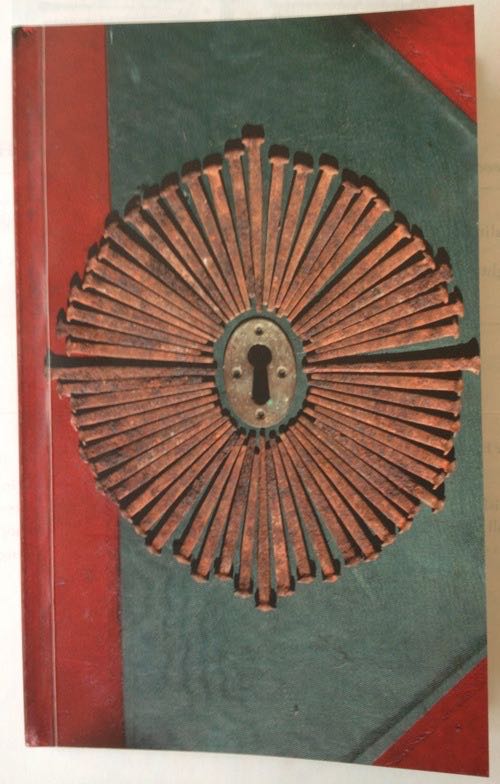
— An Antique Land. [A Cryptic Caprice ; Collected and Edited by John Shire. Brighton : Invocations Press, 2012]. Illustrated narrative essay on an imaginary book, An Antique Land by Henry Piers Thursby Curtis (1909), with bibliographic notes, excerpts from the text and from a 1997 essay ; I counted at least six layers of imaginary books at work here. Great fun. Edition of 100 copies. The editor describes An Antique Land as “ a small love-letter to books ”. Shire is also author of a book on the history of Brighton bookshops, Bookends, that sounds promising. “ In other words, I’m still making it up as I go along. ”
— — — —
— Kristofor Minta and Herbert Pföstl. To Die No More. Blind Pony Books, [2008]. A lovely commonplace book of death : “ it should be read from cover to cover as one voice ; almost like a musical offering, for its TONE ” — Herbert Pföstl.
— — — —
—This Hermetic Legislature. Homage to Bruno Schulz. Edited by D. P. Watt and D. T. Ghetu. Bucharest : Ex Occidente Press, [published 1 June] 2012. Collection of original short stories.
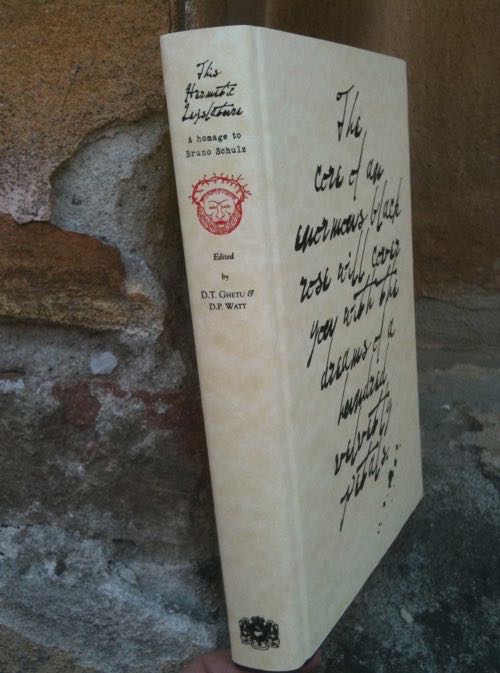
on the streets of Bucharest, publication day (photo by Dan Ghetu).
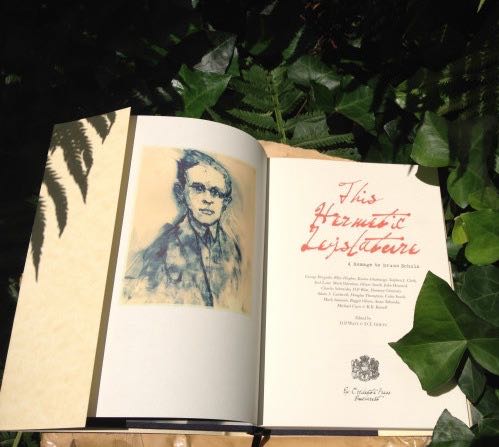
and crowned with ivy & fern
— Patricia A. McKillip. Wonders of the Invisible World. Tachyon, [forthcoming, 2012]. Advance copy of a short story collection. The title story joins Cotton Mather’s New England with a far future research project. The most successful is “ The Kelpie ”, which moves slowly from a curious and almost stifling quasi-Edwardian conventionality to a surprising incident at a north country house that confirms the vision and agency of the young woman artist at the heart of the story.
— Dave Langford. The Silence of the Langford. Essays (and some stories). NESFA Press, [second printing, 1997].
— [David Langford]. An Account of a Meeting with Denizens of Another World, 1871. David & Charles, 1979.
—John Delaney. First X, Then Y, Now Z. An introduction to Landmark Thematic Maps. Princeton University Library, 2012. Richly illustrated catalogue of a forthcoming exhibition at the library. From Francis Bacon and the frontispiece to More's Utopia to Alexander Humboldt and the pioneers of visual displays of information.
Commonplace book :
“ I am not a great believer in black and white ” — Gitta Sereny (1921-2012), quoted in FT obituary, 23 June
“ I should like also that the German publisher should pay a little . . . in advance. When they have done so, they take care of the book ” — Prince Kropotkin, in a 1903 letter.
“ I was mostly the kid with his nose in a book ” — George R.R. Martin, native of Bayonne, New Jersey, has Lunch with the FT. I hadn’t read Martin before, and enjoyed his “ Path of the Dragon ”, in The Sword & Sorcery Anthology (Tachyon) : a fine story, with a deftly played twist at end. The derivative stuff is somehow transmuted and made new (I would bet he read Fletcher Pratt), the languages euphonious, and the economy seems functioning.
— — — —
The Last Book Sale : Larry McMurtry's Booked Up (Archer City, Texas) stores 2, 3, & 4 to be sold at auction in August http://addisonsauction.com/thelastbooksale.html
— — — —

Ekaterinburg, Sverdlovsk Oblast, Russia. The flat of Eugenie Kasimov, poet. Verblessly yours, Michael Swanwick
— — — —
“ I have unfortunately lost the reference & it is a high crime, I confess, ever to refer to an opinion, without a precise reference ”
— Charles Darwin to Daniel Sharpe, 1 November 1846

Logo of The Sunwise Turn. A Modern Book Shop (New York City, 1916-1927). From the archive of Mary Mowbray-Clarke.
Thinking about Avram Davidson
This photograph * of a cotton-tree is from an album in the Graphic Arts Collection, Princeton University Library, with photographs pertaining to the 1865 Morant Bay rebellion in Jamaica. In an article in the Princeton University Library Chronicle , “ Hidden Textures of Race and Historical Memory: The Rediscovery of Photographs Relating to Jamaica’s Morant Bay Rebellion ”, Mimi Sheller writes
Its battered-looking, ancient roots stand half on land and half in water, which seems to lap at the base of the tree, forming a junction not only of crossroads but also between water and land, and thus between the spirit world and the material world . . .
The cotton-tree, or “ silky-tree ”, is at the core of a story by Avram Davidson, “ There Beneath the Silky-Tree and Whelmed in Deeper Gulphs than Me ” (Other Worlds 2, ed. Roy Torgeson. Zebra, 1980 ; ¡ Limekiller !, eds. Grania Davis and Henry Wessells. Old Earth Books, 2003). It is the most baroque and digressive of the Limekiller stories (the title alludes to a poem by William Cowper about his own misery, referring to an account of a sailor washed overboard from George Anson's ship : But I beneath a rougher sea, / And whelm'd in deeper gulfs than he.) ; what Sheller writes of the Jamaican cotton-tree applies equally to the silky-tree in British Hidalgo. And when Davidson summons the poem in his tale, it is because Jack Limekiller has survived a fate more perilous than drowning or misery.
I re-read “ There Beneath the Silky-Tree . . . ” when I saw that picture in the Chronicle, and I also re-read “ A Far Countrie ” (Asimov’s, Nov. 199 ; also collected in Ń Limekiller ! ), the last in the sequence, equally rich in allusions to Oscar Wilde; one morning, sleepless and leafing through a standard anthology **, I found that the source of Davidson’s title is a Thomas Hardy tale, “ The Three Strangers ” (Longman’s Magazine, March 1883), where a visitor to a remote shepherd’s cottage on a stormy night sings to his hosts a quaint old song that Davidson adapted to the antiquated ways and curious pronunciations of the white creoles of Woodcutters Cove in British Hidalgo.
I have been reading and thinking about Avram Davidson for nearly 20 years, and it is a pleasure to report that I am still finding links and sources and uncharted depths.
* — http://blogs.princeton.edu/graphicarts/2009/10/album_covering_the_jamaica_reb.html
** — Great Tales of Terror and the Supernatural . Edited by Herbert A. Wise and Phyllis Fraser. The Modern Library, n.d. [copyright 1944]. This anthology, which I must have bought while a teenager at boarding school, was more or less canonical — there was no other game in town : it is very interesting to look at the Modern Library Giant again in light of Peter Straub’s new, decidedly canonical anthology for the Library of America : American Fantastic Tales. Terror and the Uncanny. From Poe to the Pulps (2009). The other morning, looking at the table of contents, I recognized something else : that long ago in the woods at Camp Choconut, one or two of the camp counselors would read stories from this book by flashlight to a darkened cabin of boys : “ The Most Dangerous Game ” or “ Leiningen versus the Ants ” or a tale from Poe. And scare us out of our wits. ¶ John Clute, in his brilliant review of the Straub anthology, remarks that “ only two — Richard Connell and Carl Stephenson — seem to have returned to the elements. ” Clearly he never went to a pacifist anti-authoritarian summer camp in the woods. Even so, Great Tales has a lot to answer for : in the notes to “ The Rats in the Walls ”, its editors repeated August Derleth’s fabrication of a unified Lovecraftian mythos for a generation to come. ¶ But it is one of the books that drew your correspondent into the labyrinth of the fantastic . . .
It is never too late to give up our prejudices. — Thoreau
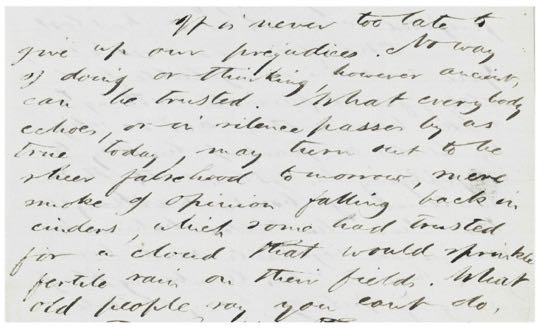
It is never too late to give up our prejudices. — Thoreau [from Walden, chapter 1]
The verso of this autograph manuscript leaf from Walden continues :
One farmer says to me, you can't live on vegetable food solely, for it furnishes nothing to make bones with . . . walking all the while he talks behind his oxen, whose vegetable-made bones jerk him and his lumbering plow along in spite of every obstacle.
As always with Thoreau, the entire chapter is worth looking into.
This manuscript leaf sold at Christie’s on 22 June 2012 :
http://www.christies.com/lotfinder/books-manuscripts/thoreau-henry-david-autograph-manuscript-a-5578301-details.aspx
31 May - 1 June 2012
Shelley’s Ghost : The Afterlife of a Poet
The treasures of the Pforzheimer collection and the Bodleian Library, on view at this profoundly moving exhibit at the New York Public Library, through 24 June 2012
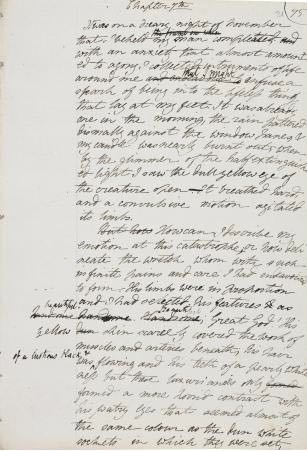
Including, in no particular order, a fair copy of Ozymandias, the Pforzheimer copy of Frankenstein in pink boards, pages from Mary Shelley’s original manuscript of the novel, a newly-discovered copy of Frankenstein with presentation to Lord Byron “ from the Author ”, a necklace made of Mary Wollstonecraft’s hair (with lockets containing the hair of Percy and Mary Shelley), Shelley’s Vindication of Natural Diet (1813) and Adonais (Pisa, 1821), a mourning ring made for Byron’s family and friends, and much more inside the tiny exhibition space. Their lives were brief and marked with sorrow; and also joy.
http://exhibitions.nypl.org/biblion/outsiders/shelleys-ghost/about-exhibition
And a beautifully illustrated companion volume:

— Stephen Hebron and Elizabeth C. Denlinger. Shelley’s Ghost. Reshaping the Image of a Literary Family. Bodleian Library, [2010].
‘ The Mirror of Perfect Friendship ’
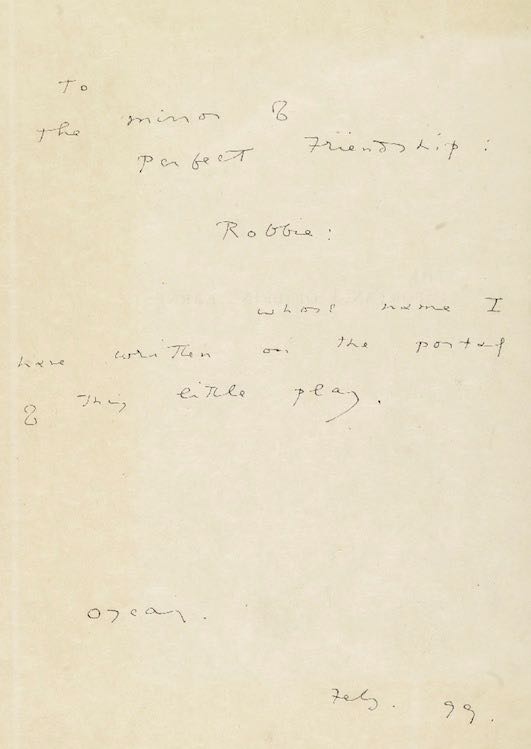
— [Oscar Wilde]. The Importance of Being Earnest. A Trivial Comedy for Serious People. London : Leonard Smithers and Co., 1899. The dedication copy, in the publisher’s gilt vellum binding, inscribed to Robert Ross. Illustrated in Mason, A Bibliography of Oscar Wilde, p. 428. Provenance : Robert Ross ; Edith Pyre (sale, Parke-Bernet, 6 December 1947, lot 463) ; Scribner’s ; Jacques Levy (sale, Sotheby’s 20 April 2012, lot 366).
A landmark of world literature. I bought this book at auction ; it lingered on my desk for all of half an hour before going on to the next chapter in its existence ; and I am still awestruck that such a beautiful token of friendship survives, and delighted to have had a small part in its history.
Secret Europe
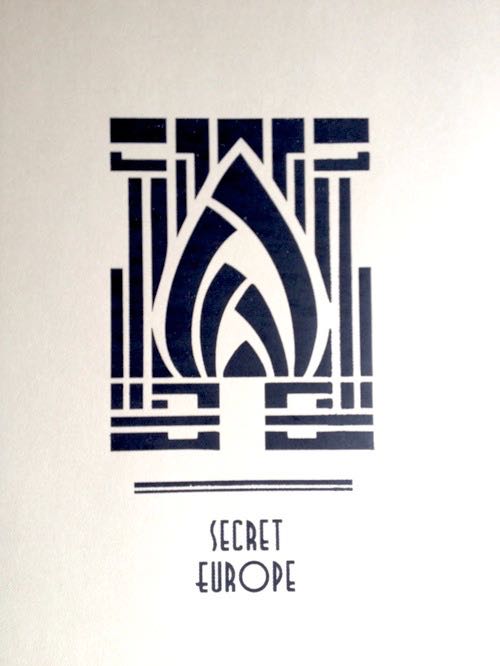
— Mark Valentine & John Howard. Secret Europe. Bucharest : Exposition Internationale, 2012. Edition of 200 copies (detail of dust jacket above). Collection of 25 stories. Valentine and Howard re-write the imaginative geography of continental Europe. A superbly produced book that came in a parcel from Rumania :

portrait of a great reader
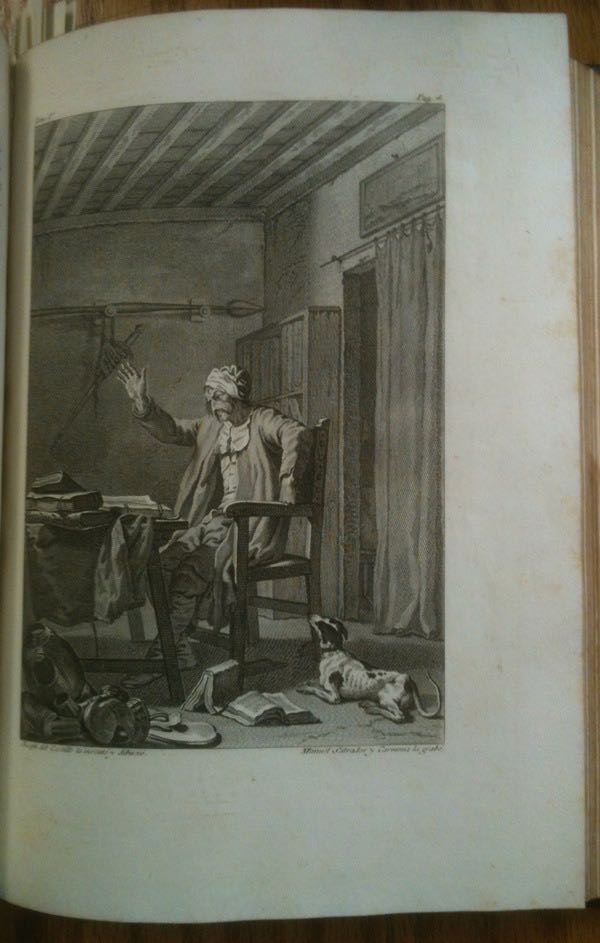
Portrait of Don Quixote, engraving in : El Ingenioso Hidalgo Don Quixote de la Mancha. Madrid, 1780.
Just received : The Sword & Sorcery Anthology
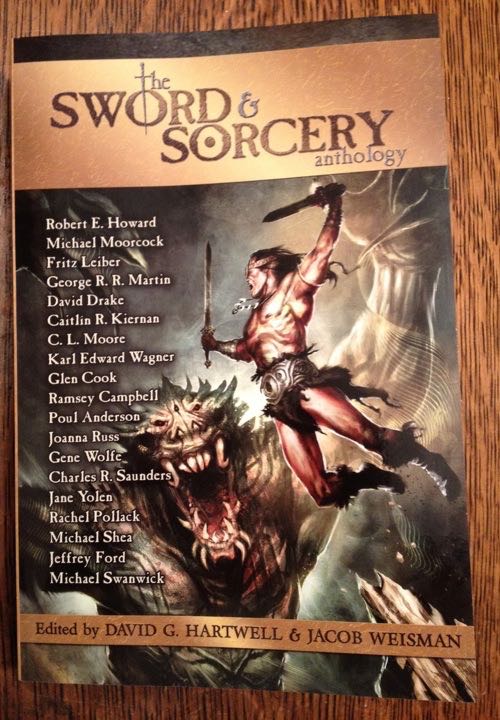
1910
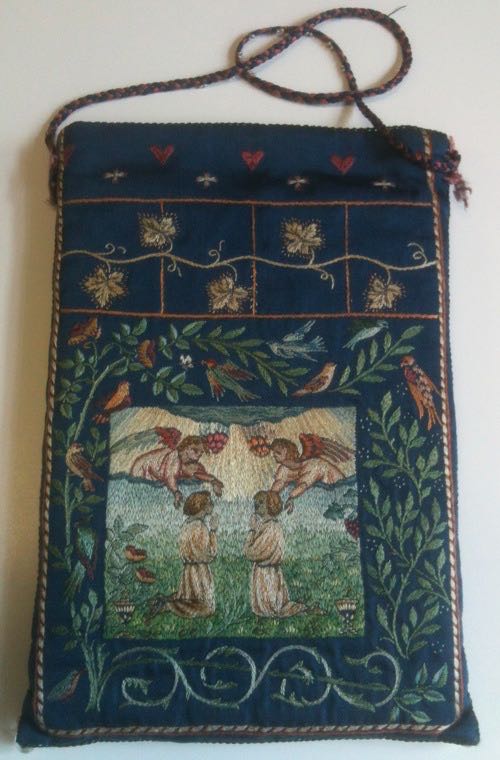
Embroidered bag by May Morris, 1910 (to hold a book).
Sharp little book
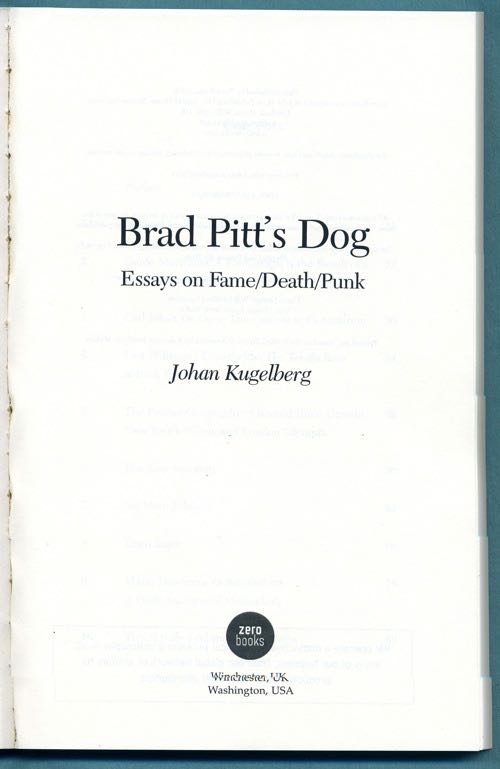
— Johan Kugelberg. Brad Pitt’s Dog. Essays on Fame/Death/Punk. Zero Books, [2012].
This is a really fine, bad book — gleefully bad and obnoxious in its title and the author’s grating, genial, and obsessive tone ; and also bad in the sense of the sense of poorly assembled (unreliable table of contents, no proofreading, faulty possessives, and no context of previous publication). Quite an accomplishment. And standing there in the prose are some beautiful passages and provocative sentences :
The mechanics of the lonely death of a wretched heart can be expressed.
. . . the age of enlightenment, when all the sciences and disciplines co-existed peacefull with myth, legend and dreams, perfectly mirrors the early days of punk rock.
History has ended and what was once directly lived has now receded into a representation.
And some very funny moments, as well. Jack Womack’s afterword, needle sharp and deflating some of Kugelberg’s bombast, is worth the price of admission to the carnival side-show : “ Hear me ; the only Golden Age you’ll ever know is the one you’re living in. ”
Irritating, the rantings of a mad auto-didact, and yet Kugelberg sees true, knows very clearly the line the collector marchesand the nature of the lists people like to check . . . A very smart man with a gift for eliciting a response.
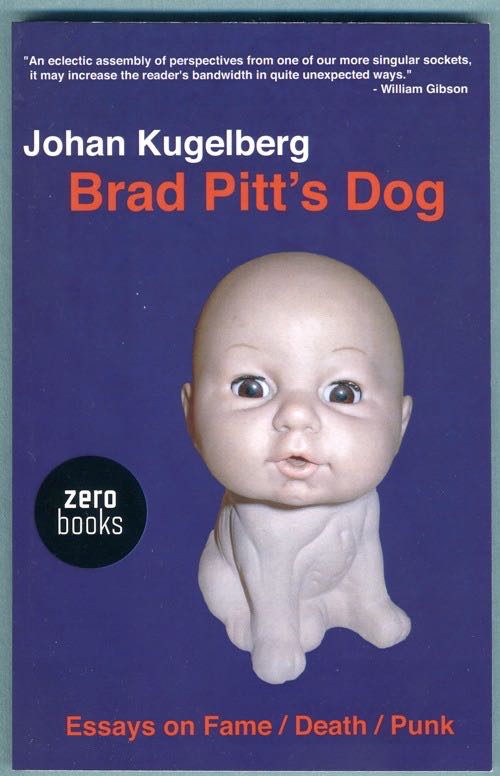
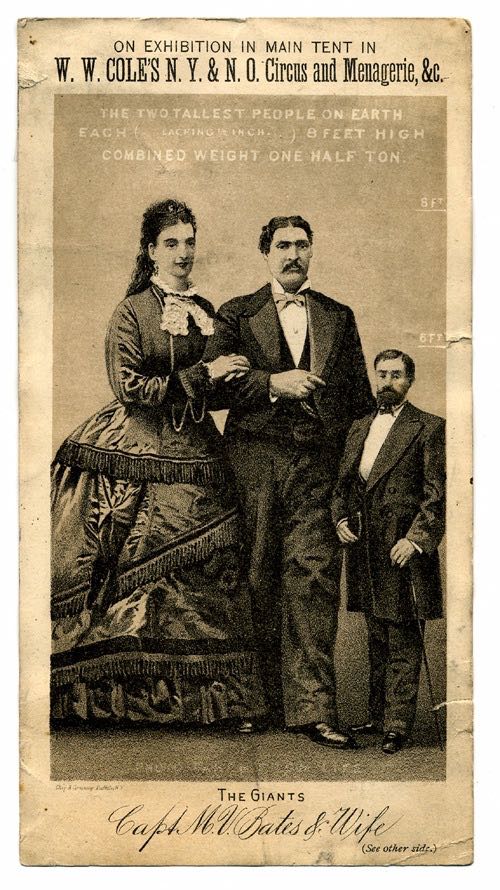
Recent Reading
— Roland Folter. Printed in the Mind of Man : The Strange World of Catalogues of Imaginary Books [2007 ; separate printing, 2011]. J. Fischart. Catalogus Catalogorum (1590) : this catalogue of nonexistent books preceded all known auction and booksellers’ catalogues !
— Michael J. Franklin. Orientalist Jones. Sir William Jones, Poet, Lawyer, and Linguist, 1746-1794. Oxford University Press, [2011].
— Brian Aldiss. An Exile on Planet Earth. Bodleian Library, [2012].
— Jacques Réda. Les Ruines de Paris. [1977] ; NRF Gallimard, [2010].
— Elizabeth Hand. Available Dark. Minotaur Books, [2012].
— Robert Sheckley. Store of the Worlds. The Stories of Robert Sheckley. Edited and with an introduction by Alex Abramovich and Jonathan Lethem. NYRB Classics, [2012]. The Sheck-man published by the academy ! A rather conservative, or at least unadventurous, selection of stories (chiefly from the 1950s, with the essential “ Cordle to Onion to Carrot ”). A much broader range of stories is to be found in Robert Sheckley’s own collection Is That What People Do ? (1984). Distressingly, in the present collection, the text of that story, “ Is That What People Do ? ”, concludes with two unrelated sentences not in the original story. Was no one reading the book inside the academy ? [Your correspondent informed the publishers and received the doubtful assurance that the text would be corrected in the electronic version.]
— Memories of the Diamond A. A gathering of stories and recollections by Charles and Ann Loughridge of life on the Diamond A Cattle Company during the late Forties and early Fifties. Compiled by Leon Loughridge. Denver : Dry Creek Art Press, [2008]. With pictorial woodblock endsheets, page borders printed by hand. Edition of 46 copies.
— William Beckford. Biographical Memoirs of Extraordinary Painters [1780]. Edited with an Introduction and Notes by Robert J. Gemmett. Fairleigh Dickinson University Press, [1969]. Fabulous, satirical biographies of artists, an astute criticism of art-speak of the late eighteenth century.
The Last Three & other matters
from DK :
— Stanislaw Lem. The Chain of Chance.
— James Blish. They Shall Have Stars (1957).
— Ursula K. Le Guin. Roccannon’s World.
from MLV :
— Ange Vlachos. Their Most Serene Majesties (The Bodley Head, 1963). Historical novel
in translation from the Greek by Kay Cicellis, a chronicle of the last Comneni
Byzantine Emperors, late twelfth century : includes a dialogue with the devil, who is a
Gnostic.
— D.A. Powell and Kevin Prufer. Dunstan Thompson: on the Life and Work of a Lost American Master (Pleiades, 2010). Poet who settled in Cley-next-the-sea, Norfolk, in the
Forties. I found his slim Poems (1946) in faded blue boards some years ago and was
drawn by its strange refulgence. This guide hopes to start a revival.
— Prince Constantine of Bavaria. After the Flood (Weidenfeld & Nicolson, 1954).
Adventures in the chaotic aftermath of the Second World War, including smuggling
to safety the Crown of St Louis, and a chapter on Johann Evangelist Virgilio,
Graf
Coudenhove-Kalergi, born in Tokyo, the eccentric artist, jester and creator of
his
own duchy, Centrigloria, “ in the kingdom of Cockaigne ”.
— — — —
‘ a spring and not a pump ’
when W. E. Henley pressed Kenneth Grahame for new work, Grahame declined, saying that he
“ held himelf to be a spring and not a pump ”
(source : Peter Green, Kenneth Grahame. A Biography (1959), cited in “ Wayfarers All ”, catalogue of David Holmes’ 2008 Grolier Club exhibition)
— — — —
A great essay in NYRSF, “ The Origins of the Science Fiction Genre ” by Brian Stableford, the most compelling argument yet about the origins of science fiction as shared literary mode (in contrast to isolated landmarks), early 1860s in France, the roman scientifique :
http://www.nyrsf.com/2012/02/the-origins-of-the-science-fiction-genre-by-brian-stableford.html
— — — —
“ It’s like going for a swim on a hot day . . . Getting right out of the alphabet into a language where words are like bits of crystal. ”
— Joseph Needham, author/editor of Science and Civilization in China (cited in New York Times obituary 27 March 1995)
— — — —
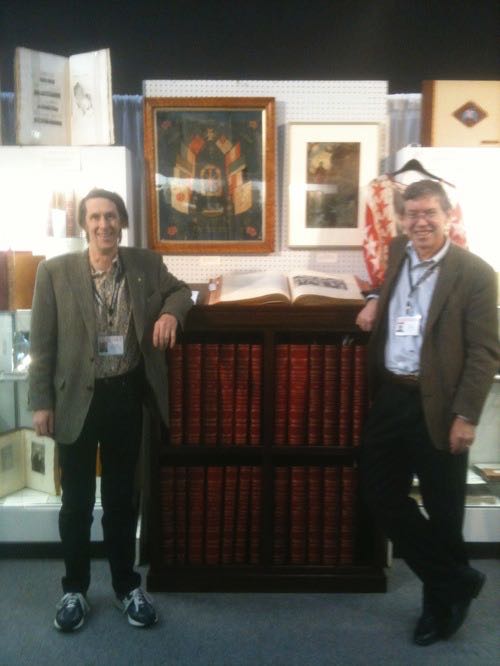
Your correspondent and a friend in the final stretch of the New York Book Fair, after the sale of the Phelps Stokes Colossus.
— — — —
Big books, little books. Even more than usual, this latest update of the Endless Bookshelf is fragmentary and subject to revision and amplification as I am able to post more pictures or remarks over the next couple of days. Your patience and correspondence are requested.
It is still possible to obtain a copy of My Man and other Critical Fictions by Wendy Walker.

Ekaterinburg, Sverdlovsk Oblast, Russia. The flat of Eugenie Kasimov, poet. Verblessly yours, Michael Swanwick
This creaking and constantly evolving website of the endless bookshelf : I expect that some entries will be brief, others will take the form of more elaborate essays, and eventually I will become adept at incorporating comments or interactivity. Right now you’ll have to send links to me, dear readers. [HWW]
electronym : wessells
at aol dot com
Copyright © 2007-2012
Henry
Wessells and individual contributors.
Produced by Temporary
Culture, P.O.B. 43072, Upper Montclair, NJ 07043 USA.
